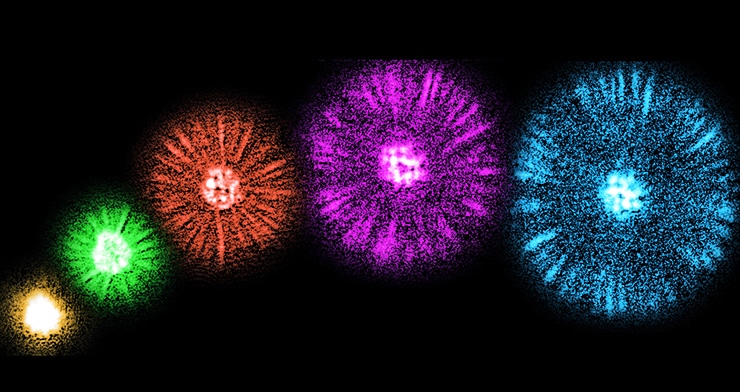Researchers have discovered a new kind of quantum behavior—and saw some fireworks in the process.
“This is a very fundamental behavior that we have never seen before; it was a great surprise to us,” says Cheng Chin, study author and professor of physics at the University of Chicago.
The research details a curious phenomenon—seen in what was thought to be a well-understood system—that may someday be useful in quantum technology applications.
Chin’s lab studies what happens to particles called bosons in a special state called a Bose-Einstein condensate. When cooled down to temperatures near absolute zero, bosons will all condense into the same quantum state.
Researchers applied a magnetic field, jostling the atoms, and they began to collide—sending some flying out of the condensate. But rather than a uniform field of random ejections, they saw bright jets of atoms shooting together from the rim of the disk, like miniature fireworks.
“If you’d asked almost anyone to predict what would happen, they would have said that these collisions would just send atoms flying off in random directions,” says postdoctoral fellow Logan Clark, the first author of the study; he and a coauthor, postdoctoral fellow Anita Gaj, were the first to see the phenomenon. “But what we see instead are thousands of bosons bunching together to leave in the same direction.”
“It’s like people forming a consensus and leaving in groups,” Chin says.

The tiny jets may show up in other systems, the researchers say—and understanding them may help shed light on the underlying physics of other quantum systems.
Moreover, the jets, like other new quantum behaviors, may be of interest in technology.
“For example, if you sent a particular atom in one direction, then a bunch more would follow in that same direction, which would help you amplify small signals in the microscopic world,” Clark says.
Since they delivered energy to the system and the particles are not at their ground states, the authors say the new behavior falls under the category of a particularly hot area of quantum engineering research called “driven” quantum systems. The physics of systems in these quantum states is not well understood, but essential for engineering useful technologies.
To create a better clock, apply this quantum ‘magic trick’
However, Bose-Einstein condensates are a generally well-studied area, so the researchers were excited to see a never-before-documented behavior, the scientists say.
“If you see something crazy in this simple experiment, it makes you wonder what else is out there,” says graduate student Lei Feng, also a study coauthor.
The researchers report their findings in the journal Nature.
The US Army Research Office, National Science Foundation, Grainger and Kadanoff-Rice fellowships, and University of Chicago Materials Research Science and Engineering Center funded the research.
Source: University of Chicago



